
Key Features
- Modular-design cutterbar
- Steel roll conditioners
- Adjustable roll pressure
- Hydraulic tongue positioning
Features
Rockshaft swivel hitch
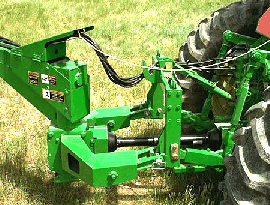 Rockshaft swivel hitch
Rockshaft swivel hitch
The swivel hitch gives the 946 and 956 Mower-Conditioners excellent maneuverability.
NOTE: Requires a 1000-rpm power take-off (PTO) (3.5 cm [1-3/8 in.]) and a 107.7-kPa (2250-psi) hydraulic system with dual selective control valves (SCVs).
NOTE: The PTO can be converted to a 4.4-cm (1-3/4-in.) driveline by installing a yoke (AE56235) and cross bearing assembly (AC15878). Order through Parts.
The rockshaft swivel hitch attaches to the lower arms of a Category 2 or 3N 3-point hitch and can be used with or without a Quik-Coupler. This hitch enables cutting square corners without the need to reposition the platform using tractor hydraulics, making it easier to cut around field obstacles.
The U-joint angles of the tractor hookup remain constant for reduced driveline noise and vibration.
The rockshaft swivel hitch is easy to hook up. The spring-loaded attaching arms are tilted upward when the hitch is set on the built-in parking pad. The arms can be positioned to permit easier alignment with the 3-point hitch arms.
NOTE: The rockshaft swivel cannot be converted to the drawbar swivel hitch configuration.
Drawbar swivel hitch
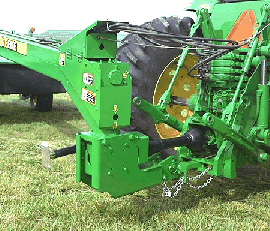 Drawbar swivel hitch
Drawbar swivel hitch
The drawbar swivel hitch attaches to the tractor drawbar with a drawbar extension. This enables the mower-conditioner to be used with tractors without a rockshaft.
The turning radius is reduced approximately 10 degrees compared to the rockshaft swivel hitch. The U-joint angles of the tractor hookup remain constant for reduced driveline noise and vibration.
The drawbar swivel hitch is designed to be towed by a tractor only (the static load on the drawbar is approximately 771.1 kg [1700 lb]) and includes a screw-type jack and safety chain.
NOTE: The drawbar swivel cannot be converted to the rockshaft swivel hitch configuration.
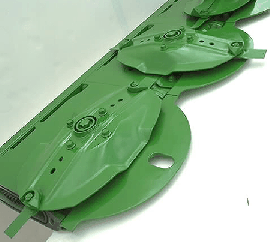 Rotary cutterbar
Rotary cutterbar

The rotary cutterbar is designed and built by John Deere. Large oval disks with free-swinging knives are used to cut the crop.
All cutting disks are the same and are computer-designed for improved wear and cutting performance.
Cutting disks are made of high-strength, austempered steel to ensure the steel is thoroughly and evenly tempered for good wear characteristics.
The disks rotate to give a knife-tip speed of 307 km/h (191 mph) for clean cutting.
The knives are free-swinging to reduce damage if a solid object is struck, and they are reversible to double the useful life.
The knives are removed at the front of the cutterbar for convenience.
Wear caps
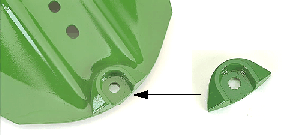 Wear caps
Wear caps
Made of austempered, heat-treated, ductile steel for excellent wear characteristics, wear caps are installed on each end of the cutting disks (except on the end disks where crop accelerators are used) to increase the wear life of the cutting disks and knife-bolt nuts.
Wear caps are open on the end to prevent debris from packing in close to the nut, making hardware and knives easier to change.
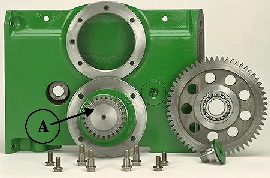 Modular cutterbar
Modular cutterbar

John Deere's patented design cutterbar is made from individual, diagonal-cut modules.
Serviceability is easy. Modules can be removed individually while leaving the cutterbar attached to the frame.
Made of high-strength, nodular iron castings, each module consists of two idler gears and one drive gear. The large-diameter idler gears transmit power from module to module. The idler gears turn at a relatively slow speed for added durability.
The smaller-diameter pinion drive gear is used only to power the cutting disk. Power is not transmitted from one cutting disk to another except through the large-diameter idler gears.
The modules are interchangeable. Disk rotation is determined by the position of the quill (A). There is a rubber oil seal between each cutting module.
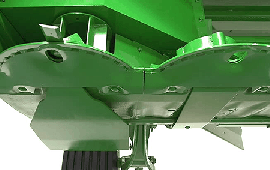 Gauge shoe
Gauge shoe
Steel runners are located under each disk. Right-hand and left-hand adjustable gauge shoes further protect the cutterbar.
The half-moon shaped disk protectors extend past the cutterbar module to protect the cutting disk.
The disk protectors are made of heat-treated boron steel, whose material characteristics are very similar to spring steel. Resistance to bending is nearly three times greater than molded ductile iron.
Knives rotate close to the disk protectors to give a good shearing action and help to keep the cutterbar clean.
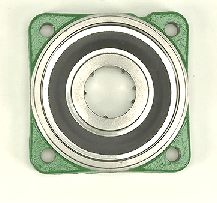 Shearhub
Shearhub
Each cutting disk is attached to a driver (shearhub) on the splined pinion gear. The driver has part of its splines removed so it will shear if the cutting disk receives a severe impact.
The shear strength of the driver is designed to be just slightly less than that of the pinion gear.
Power to the disk is interrupted when the driver shears to protect the internal components of the cutterbar.
Damage is limited to exposed components and does not require disassembly of the cutting modules.
 U-joint
U-joint
Power is transmitted through a U-joint to the first cutting disk.
The U-joint attaches with four bolts to the driver on the first cutting disk. No special tools are required to remove the first cutting disk.
The torque for attaching bolts is the same as for attaching the disk to the driver (149.1 Nm [110 lb-ft] compared to the 339 Nm [250 lb-ft] required to attach the driver to the pinion gear).
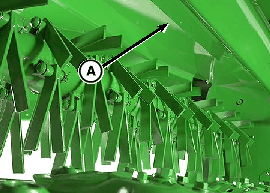 Impeller
Impeller
An impeller conditioner is available for the 946 and 956 Mower-Conditioners. Proper conditioning in a wide range of crops can be achieved when the conditioner is properly adjusted.
The impeller conditioner works well in legumes, especially alfalfa and most all-grass crops. Impeller conditioners are not recommended for thick-stemmed or cane-type crops over 1.5-m (5-ft) tall.
How an impeller conditioner works:
1. As hay is cut by rotating knives, tines pick up the plants and carry them through the machine:
- 72 V-shaped tines
- Free-swinging tines are used to reduce damage if rocks or other solid objects are struck
2. As plant passes through, it rubs against the conditioning hood (A) and other plants.
- Scrubbing action removes the waxy surface from the stem of the plant
- Allows faster evaporation of moisture
- Conditioner hood opening is adjustable to accomodate various crop volumes
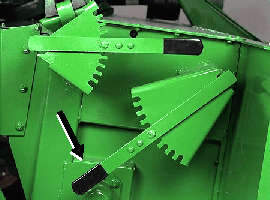 Impeller hood adjustment
Impeller hood adjustment
-
A simple lever adjustment (arrow) controls the spacing between the tines and the conditioning hood.
-
The closer the hood is to the tines, the more aggressive the conditioning is.
-
Adjustment slots give an easy reference point to control the degree of conditioning.
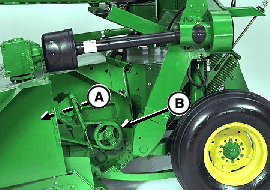 Drive and driven sheaves
Drive and driven sheaves
3. The speed at which the tines rotate will also affect the degree of conditioning. Two impeller speeds can be achieved by interchanging the drive sheave (A) and the driven sheave (B).
- With sheaves in the position shown, the impeller turns at 871 rpm, which is ideal for most crop conditions.
- Interchanging the sheaves will slow the impeller speed to 620 rpm.
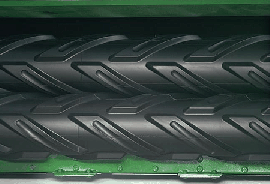 Urethane rolls
Urethane rolls
The 946 and 956 Mower-Conditioners are also available with large, 25.4-cm (10-in.) diameter, 269.2-cm (106-in.) long, molded urethane conditioner rolls.
The urethane roll conditioner works well in legumes, especially alfalfa, and most all-grass crops. In general, roll conditioners are better suited for thick-stemmed, cane-type crops, and taller grasses over 1.5-m (5-ft) tall.
Molded urethane rolls are formed by a ''cool'' molding process that does not distort or warp the steel core of the roll.
- This process ensures the rolls are straight and cylindrical, so they can be accurately spaced close together for uniform conditioning along the length of the roll.
The intermittent recessed cleat design gives more crimping edges for greater pressure per square inch, which results in superior conditioning and faster crop drying.
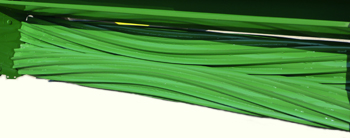 Close-up of V-10 steel conditioning rolls
Close-up of V-10 steel conditioning rolls
The V-10 steel conditioner rolls feature 10 angled flutes arranged in a chevron pattern, or V-pattern, along the length of the steel core.
Steel rolls offer improved wear life over urethane rolls, particularly in adverse crop conditions.
Advantages of the V-10 conditioner roll over the previous straight flute design are as follows:
-
More crimping edges for improved conditioning
-
Improved feeding
-
Improved windrow formation
Tri-Lobe™ steel conditioning rolls
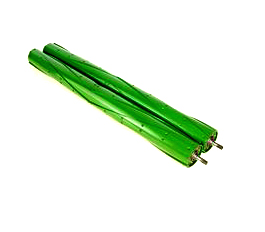 Tri-Lobe steel conditioning rolls
Tri-Lobe steel conditioning rolls
 Close-up of Tri-Lobe steel conditioning rolls
Close-up of Tri-Lobe steel conditioning rolls
Tri-Lobe steel conditioning rolls have three intermeshing chevron lobes to crush the length of the stem for improved conditioning and faster drydown. The rolls are manufactured using a patented process.
The steel material increases wear life, especially in abrasive crops or soil conditions. Durability is a distinct advantage compared to other crusher-style rolls made of rubber or urethane. The chevron design of the rolls gives positive feeding and improved crop flow.
These rolls are well suited for use in alfalfa, where reduced curing time results in less bleaching of the crop. In heavy, thick-stemmed crops, such as sudan or sudex, the steel construction of the rolls does a very good job of breaking up the nodes on the stems to improve drydown.
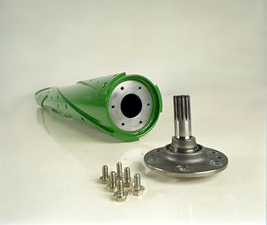 Replaceable end shafts
Replaceable end shafts
The shafts on the Tri-Lobe rolls are steel forgings that are then machined. These precision parts have minimal run-out, which means the rolls themselves rotate precisely around their axis. This precision enables the rolls to be adjusted to a minimum clearance for consistent conditioning along the length of the rolls.
The machined, forged roll ends are bolted into the core of the Tri-Lobe steel roll. In the event a roll end is damaged, the entire roll does not need to be replaced. Each shaft can be replaced individually, resulting in lower repair costs.
For serviceability, each roll end has two threaded holes, so that bolts can be used to pull the shafts from the steel core of the roll.
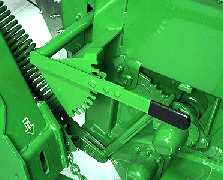 Roll conditioner swathboard lever
Roll conditioner swathboard lever
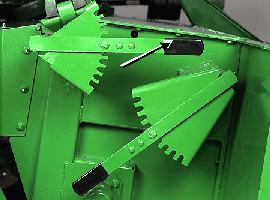 Impeller conditioner swathboard lever
Impeller conditioner swathboard lever
An easy-to-adjust lever (arrow) is used to position the swathboard.
The swathboard controls the crop flow into the windrow-forming shields.
The windrow width is adjustable from 101.6 cm to 254 cm (40 in. to 100 in.), depending on crop conditions, when equipped with a roll conditioner or an impeller conditioner.

